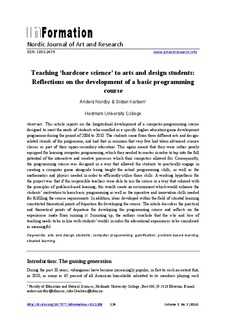Teaching ‘hardcore science’ to arts and design students: Reflections on the development of a basic programming course.
Journal article, Peer reviewed
Permanent lenke
http://hdl.handle.net/11250/276625Utgivelsesdato
2014Metadata
Vis full innførselSamlinger
Originalversjon
Nordby, A. & Karlsen, S. (2014). Teaching ‘hardcore science’ to art and design students: Reflections on the development of a basic programming course. InFormation - Nordic Journal of Art and Research, 3(2), 129-142. doi: 10.7577/information.v3i2.1208 10.7577/information.v3i2.1208Sammendrag
This article reports on the longitudinal development of a computer-programming course
designed to meet the needs of students who enrolled in a specific higher education game development
programme during the period of 2006 to 2010. The students came from three different arts and designrelated
strands of the programme, and had that in common that very few had taken advanced science
classes as part of their upper-secondary education. This again meant that they were rather poorly
equipped for learning computer programming, which they needed to master in order to tap into the full
potential of the interactive and creative processes which their computers allowed for. Consequently,
the programming course was designed in a way that allowed the students to practically engage in
creating a computer game alongside being taught the actual programming skills, as well as the
mathematics and physics needed in order to efficiently utilise those skills. A working hypothesis for
the project was that if the responsible teachers were able to run the course in a way that cohered with
the principles of problem-based learning, this would create an environment which would enhance the
students’ motivation to learn basic programming as well as the operative and innovation skills needed
for fulfilling the course requirements. In addition, ideas developed within the field of situated learning
constituted theoretical points of departure for developing the course. The article describes the practical
and theoretical points of departure for developing the programming course and reflects on the
experiences made from running it. Summing up, the authors conclude that the why and how of
teaching needs to be in line with students’ worlds in order for educational experiences to be considered
as meaningful.
Beskrivelse
This is an Open Access article licensed under the Creative Commons Attribution International License 4.0 (CC BY) and originally published in InFormation : Nordic journal of art and Research. You can access the article by following this link: https://journals.hioa.no/index.php/information/article/view/1208
